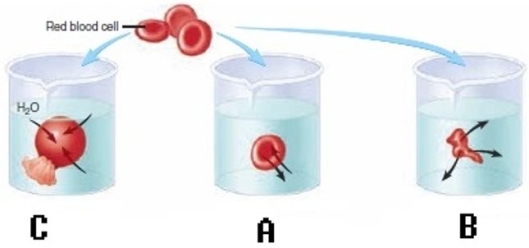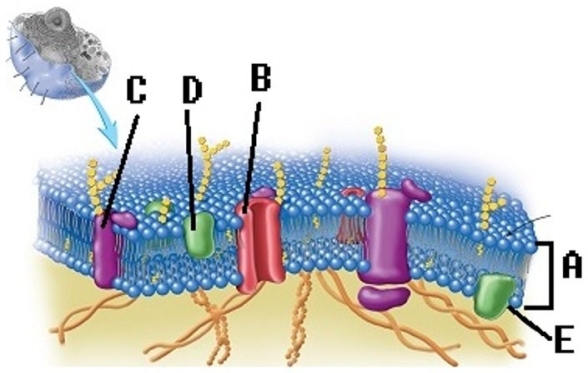A) pre-mRNA.
B) proenzyme.
C) gene.
D) ribosomal RNA (rRNA) .
E) codon.
G) A) and C)
Correct Answer

verified
Correct Answer
verified
Multiple Choice
Active transport
A) follows osmotic pressure gradients.
B) can move substances along their concentration gradient.
C) does not require metabolic energy (ATP) .
D) involves vesicle formation.
E) requires ATP.
G) B) and C)
Correct Answer

verified
Correct Answer
verified
Multiple Choice
A red blood cell that is placed in a hypertonic solution
A) loses water.
B) gains water.
C) floats.
D) ruptures.
E) neither gains nor loses water.
G) A) and E)
Correct Answer

verified
Correct Answer
verified
Multiple Choice
Which of the following is NOT true of G-protein complex action?
A) Stimulates a cell by means of extracellular chemical signals
B) Stimulates a cell by opening ion channels in the plasma membrane
C) Stimulates a cell by means of intracellular chemical signals
D) Stimulates a cell by activating enzymes associated with the plasma membrane
E) Acts as an intermediate between a receptor and other cellular proteins
G) A) and B)
Correct Answer

verified
Correct Answer
verified
Multiple Choice
Membrane-bound receptors
A) are small, lipid soluble molecules.
B) have their receptor sites on the outer surface of the plasma membrane.
C) can interact with DNA in the nucleus.
D) do not exhibit specificity.
E) have no effect on the cell.
G) B) and D)
Correct Answer

verified
Correct Answer
verified
Multiple Choice
 -Red blood cells (RBCs) have been placed in three different solutions: hypotonic, hypertonic, isotonic. What is solution "A" relative to the RBC?
-Red blood cells (RBCs) have been placed in three different solutions: hypotonic, hypertonic, isotonic. What is solution "A" relative to the RBC?
A) Hypotonic solution
B) Hypertonic solution
C) Isotonic solution
E) None of the above
Correct Answer

verified
Correct Answer
verified
Multiple Choice
Which of these cells would most likely have the largest number of mitochondria?
A) Bone cells
B) Skeletal muscle cells
C) Adipocytes
D) Red blood cells
E) Skin cells
G) A) and E)
Correct Answer

verified
Correct Answer
verified
Multiple Choice
The collection of carbohydrates, glycolipids, and glycoproteins of the plasma membrane is called the ________.
A) fluid mosaic
B) extracellular membrane
C) intercellular fluid
D) phospholipid
E) glycocalyx
G) B) and E)
Correct Answer

verified
Correct Answer
verified
Multiple Choice
Internal structures of a cell that carry out specialized metabolic tasks are called ________.
A) organelles
B) ribosomes
C) enzymes
D) cytoskeletal elements
F) A) and B)
Correct Answer

verified
Correct Answer
verified
Multiple Choice
Which of the following is NOT consistent with active transport?
A) Movement is against a concentration gradient
B) Movement is with a concentration gradient
C) Involves a carrier
D) Exhibits competition and saturation
E) Uses cell energy
G) All of the above
Correct Answer

verified
Correct Answer
verified
Multiple Choice
The lower limit of resolution of a light microscope is ________.
A) 100μm
B) 0.1μm
C) 10μm
D) 0.01μm
E) 1.0μm
G) A) and E)
Correct Answer

verified
Correct Answer
verified
Multiple Choice
Which of the following terms does NOT relate to the mitochondrion?
A) Cristae
B) Self-replicating
C) Outer and inner membranes
D) ATP
E) Vitamin A storage
G) A) and B)
Correct Answer

verified
Correct Answer
verified
Multiple Choice
Which of the following organelles function in the destruction of nonfunctional organelles?
A) Endoplasmic reticulum
B) Centrioles
C) Basal bodies
D) Lysosomes
E) Mitochondria
G) A) and E)
Correct Answer

verified
Correct Answer
verified
Multiple Choice
 -Red blood cells (RBCs) have been placed in three different solutions: hypotonic, hypertonic, isotonic. What is the condition of the RBC in solution "C"?
-Red blood cells (RBCs) have been placed in three different solutions: hypotonic, hypertonic, isotonic. What is the condition of the RBC in solution "C"?
A) Phagocytized
B) Normal
C) Coagulated
D) Hemolyzed
E) Crenated
G) A) and B)
Correct Answer

verified
Correct Answer
verified
Multiple Choice
Which type of cell would have an abundance of lysosomes?
A) White blood cell, a phagocyte
B) Mucus cell (secretes mucus)
C) Liver cells that detoxify hydrogen peroxide
D) Cardiac muscle cells (require large amounts of ATP)
E) Fibroblast (makes protein fibers)
G) B) and C)
Correct Answer

verified
Correct Answer
verified
Multiple Choice
A cell that breaks down and recycles proteins would have large numbers of ________.
A) rough ER
B) lysosomes
C) peroxisomes
D) secretory vesicles
E) proteosomes
G) A) and D)
Correct Answer

verified
Correct Answer
verified
Multiple Choice
 -What structure does "D" represent on the diagram of the plasma membrane?
-What structure does "D" represent on the diagram of the plasma membrane?
A) Membrane channel protein
B) Phospholipid bilayer
C) Internal membrane surface
D) Peripheral protein
E) Integral protein
G) None of the above
Correct Answer

verified
Correct Answer
verified
Multiple Choice
Which of the following is NOT a characteristic function of a cell?
A) Reproduction and inheritance
B) Metabolism and energy use
C) Movement
D) Synthesis
E) Communication
G) A) and B)
Correct Answer

verified
Correct Answer
verified
Multiple Choice
A cell's ability to replenish ATP is reduced by a metabolic poison. Which organelle is being affected?
A) Nucleus
B) Centriole
C) Microtubule
D) Mitochondrion
E) Ribosome
G) A) and C)
Correct Answer

verified
Correct Answer
verified
Multiple Choice
In general, water-soluble molecules diffuse through the ________; and lipid-soluble molecules diffuse through the ________.
A) membrane channels; membrane channels
B) membrane channels; lipid bilayer
C) lipid bilayer; membrane channels
D) lipid bilayer; lipid bilayer
E) None of the choices are correct.
G) All of the above
Correct Answer

verified
Correct Answer
verified
Showing 41 - 60 of 230
Related Exams